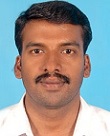International Conference on Coastal Zones
Osaka, Japan

Vijay Prabhu
Post Doctoral Fellow,Hydrogeology Lab, Department of Geology, Periyar University,India
Title: Delineation of Fresh and Seawaters Interface using Geospatial Techniques in the Ramanathapuram Coastal Aquifer System Tamil Nadu South India
Biography
Biography: Vijay Prabhu
Abstract
Seawater intrusion is a global issue nearly three quarters of the world population live near or on the coast, as found to be true in India also, which has about 7,500 km of coastline with many sprawling and still growing coastal cities. Ramanathapuram coast is one of the important coastal areas for developed biodiversity in Tamil Nadu State,India. In 1986, a group of 21 islands lying off the Tamil Nadu coast between Thoothukudi and Dhanushkodi was declared the Gulf of Mannar Marine National Park its 10 km buffer zone was declared a Biosphere Reserve in 1989 by the govt.of India. The coastal regulation is thus a place of hectic human activity, resulting in human interference because of rapid development, such as rapid urbanization, harboring, fisheries, aquaculture and recreation, etc. The coastal ecosystem and landforms is now highly disturbed and very much threatened, by problems like exploitation of groundwater in coastal aquifer system, salt water intrusion, pollution, siltation, erosion, flooding, storm surges and ever expanding human settlements. In many coastal aquifers, the intrusion of seawater has become one of the major constraints imposed on groundwater utilization for the domestic, agricultural and industrial purposes. Seawater intrusion progresses, existing pumping wells, especially those close to the coast, become saline and have to be increased towards the landward side. Also, the area above the intruding seawater wedge is lost as a source of natural replenishment to the aquifer. The present study is mainly focusing on delineation of fresh and seawaters interfaces in the Ramanathapuram coast and find out remedial measures for sustainable development. The methodology adopted in the present study is Remote sensing, LANDSAT image and GPS data were used as primary data for extracting the shorelines. The base map of the study area has been prepared from Survey of India (SOI) Toposheet maps Nos. 58 N/11 (1971), 13,14 &15 (1970) on 1:50,000 scale. Different image processing techniques have been carried out to enhance the change deduction analysis. The southern coastal area of Tamil Nadu faces severe threat due to rapid changes in geology and geomorphology. This map is being extracted from the Geological Survey of India map and satellite image. Rainfall and water level data were collected from district meteorological stations for the latest years. The geophysical resistivity survey needs have been conducted in the various locations along the coast buffered from the sea shore line up to 1000 meters into the land and interpreted in terms of subsurface lithology / anomaly and seawater intrusion mapping for various depths along the coast. Through this study aquifer unit and their vertical and lateral extend of single and multilayered aquifer system was delineated. Water quality studies were carried out with some major elements and interpreted to assess its suitability for drinking and irrigation purposes. Delineation of fresh and saline water sharp interface is very essential to prevent and protect further degradation of landforms as well as the ecosystem. The aquifer management plan was developed based on the subsurface geological condition. By presenting this fairly comprehensive volume of knowledge and experience on seawater intrusion. The outcome could be more useful for coastal zone planners and policy makers.
